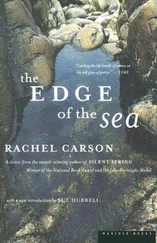Now that the sediments have been measured over much greater areas of the ocean floor, the reaction of oceanographers is one of considerable amazement— but their surprise concerns the fact that on the whole the mantle of sediments is so much thinner than related facts would lead them to expect. Over vast areas of the Pacific the average thickness of the sediments (unconsolidated sediments plus sedimentary rock) is only about a quarter of a mile. It is little thicker over much of the Atlantic. (These are average figures; some much deeper deposits of course exist.) In some areas there has been almost no sedimentation. A few years ago several oceanographers obtained photographs of manganese nodules lying on the floor of the Atlantic at great depths and of others on the Easter Island Ridge of the southeast Pacific. Sharks’ teeth dating from the Tertiary, hence possibly as much as 70 million years old, sometimes form the nuclei of these nodules. Certainly their growth, by deposit of successive layers around the nuclei, must be very slow. Hans Pettersson has estimated a growth of about 1 mm. per thousand years. Yet during the period these nodules have lain on the ocean floor, sediments deep enough to cover them have not been accumulated.
Some idea of the rate of sedimentation during post-glacial time has been gained by observation of the rate of radioactive decay of some of the components of the sediments. If this sedimentation rate had prevailed during the supposed life of the oceans, the average thickness of the sediments would be enormously greater than it now appears to be. Did much of the deposited sediments dissolve? Were most of the present land masses submerged for far greater periods than we now assume, with consequently long periods of slight erosion? These and other explanations of the mystery of the sediments have been suggested, but none seems wholly satisfying. Possibly the dramatic project of boring holes in the floor of the ocean down to the Mohorovicic discontinuity (Project Mohole; see Preface) will provide the explanation that is now lacking.
From The Changing World of the Ice Age, 1934 edition, Yale University Press, p. 210.
From Transactions, Geol. Soc. Cornwall, vol. v, 1843.
From Annual Rept., Smithsonian Inst., 1947.
From the time of its establishment up to 1960, the warning system has issued eight alerts warning residents of the Hawaiian Islands of the approach of seismic waves. On three of these occasions, waves of major proportions have in fact struck the islands. None have been so large or so destructive, however, as those of May 23, 1960, which spread out across the Pacific from their place of origin in violent earthquakes on the coast of Chile. Without such warning the loss of life would almost certainly have been enormous. As soon as the seismograph at the Honolulu Observatory recorded the first of the Chilean quakes the system went into operation. Reports from the scattered tide stations gave ample notice that a seismic wave had formed and was spreading out across the Pacific. By early news bulletins and later by an official “sea wave warning” the Observatory alerted residents of the area and predicted the time the wave would arrive and the areas to be affected. These predictions proved to be accurate within reasonable limits, and although property damage was heavy, loss of life was limited to the few who disregarded the warnings. Sea wave activity was reported as far west as New Zealand and as far north as Alaska. The Japanese coasts were struck by heavy waves. Although the United States warning system does not now include other nations, officials at Honolulu sent to Japan warnings of the wave which, unfortunately, were disregarded.
The warning system now (in 1960) consists of eight seismograph stations at points on both eastern and western shores of the Pacific and on certain islands, and of twenty widely scattered wave stations, four of which are equipped with automatic wave detectors. The Coast and Geodetic Survey feels that additional wave-reporting tide stations would improve the effectiveness of the system. Its principal defect now, however, is the fact that it is not possible to predict the height of a wave as it reaches any particular shore, and therefore the same alert must be issued for all approaching seismic waves. Research on methods of forecasting wave height is therefore needed. Even with its present limitations, however, the system has filled so great a need that there is strong international interest in extending it to other parts of the world.
The flood of ocean waters that overwhelmed the coast of the Netherlands on February 1, 1953, deserves a place in the history of great storm waves. A winter gale that formed west of Iceland swept across the Atlantic and into the North Sea. All its force was ultimately brought to bear on the first land mass to obstruct the course of its center—the southwestern corner of Holland. The storm-driven waves and tides battered against the dikes in such bitter violence that these ancient defenses were breached in a hundred places, through which the flood rushed in to inundate farms and villages. The storm struck on Saturday, January 31, and by midday of Sunday one-eighth of Holland was under water. The toll included about half a million acres of Holland’s best agricultural land—ravaged by water and permeated with salt—thousands of buildings, hundreds of thousands of live stock, and an estimated 1400 people. In all the long history of Holland’s struggle against the sea, there has been no comparable assault by ocean waters.
From Am. Phil. Soc. Trans., vol. 2, 1786.
It is now the fashion among oceanographers to speak of the Gulf Stream System, reflecting the discovery that east of Cape Hatteras there is no longer a continuous river of warm water but a “series of overlapping currents arranged somewhat like the shingles on a roof.” Not only do the streams “overlap” but they are narrow and swift. The main branches of the stream that have long been recognized east of the Grand Banks are now known to originate far to westward of the Banks, developing not as branches in the ordinary sense but as a series of new currents, each to the north of the next older one.
As oceanographers study more about the dynamics of circulation in the sea, they are more and more struck by parallels between the ocean of water and the ocean of air. One of the leading students of the Gulf Stream, Columbus Iselin, has commented on the branching of the Stream in terms of a fascinating analogy: “Much the same phenomena seem to be present in the jet streams found at high elevations in the great belts of prevailing westerly winds of mid-latitudes,” he says, “although each atmospheric jet has greater dimensions than the overlapping subdivision of the Gulf Stream System.”
One of the most exciting recent events in oceanography was the discovery of a powerful current running under the South Equatorial current but in the opposite direction. The core of the counter current lies about 300 feet below the surface (although shallower near its eastern terminal in the vicinity of the Galapagos Islands). This subsurface current is about 250 miles wide and it flows at least 3500 miles eastward along the equator at a speed of about 3 knots. (The speed of the surface current is only about one knot.) The existence of the current was discovered in 1952 by Townsend Cromwell in the course of a U.S. Fish and Wildlife Service investigation of methods of tuna fishing. Cromwell observed that long lines set for tuna at the equator did not move westward with the surface current, as would be expected, but drifted rapidly in the opposite direction. It was not until 1958, however, that an extensive survey of the current was made by the Scripps Institution of Oceanography and its impressive dimensions measured. This same survey gave further proof that the deep circulation of the ocean is far more complicated than has generally been realized, for beneath the swift-flowing eastward current was still another, flowing to the west. In only the uppermost half mile of Pacific equatorial waters, therefore, there are three great rivers of water, one above the other, each flowing on its own course independent of the other. When such surveys can be extended all the way to the floor of the ocean an even more complex picture will undoubtedly be revealed.
Читать дальше












